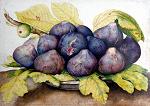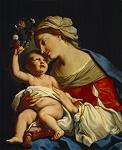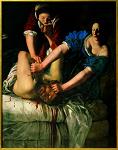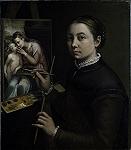 |

Giovanna Garzoni
Plate of Figs
This stimulating display of more than 60 works by 15 women artists span a variety of media from prints and drawings to paintings and sculptures. So while Italian Women Artists from Renaissance to Baroque presents us with the requisite images of still-lifes filled with fruits or flowers, for example Giovanna Garzoni's Plate of Figs, and of the Madonna in Elisabetta Sirani's Virgin and Child, our careful viewing of the displayed works provides new insights into the cultural milieu and ambience of discovery of these artists. The significance of this museum, this exhibition, and these artists is evidenced by the simple fact that almost three quarters of the displayed images, that is 45 works, are on loan from collections in Italy, Poland, Vienna, and London as well as from a variety of private collections.

Elisabetta Sirani
Virgin and Child
Artemisia Gentileschi and Barbara Longhi have painted variations on the theme of the early 4th-century female saint, Catherine of Alexandria. While it was common for women artists to present or represent depictions of female heroes or saints as the focus of their works, the topos of Catherine of Alexandria and the similarities between the two paintings deserve comment. The saint's biography identified her as a feminine model of Christian virtue and of elegance and erudition. Catherine was a learned woman who entered into debate with the some thousand pagan philosophers. According to tradition, her cogent arguments and philosophical knowledge astounded all who heard her, and she won this great debate which resulted in the conversion of these pagan philosophers and their followers. Both artists depict her from a three-quarter view, standing with the spiked wheel of her martyrdom tucked under her left arm.

Artemisia Gentileschi
Judith Slaying Holofernes
Galizia even goes so far in her identification with this active and brave woman that she signs her name and the date on the blade of Judith's sword. These Judiths are first and foremost renown for their beauty, courage, and devotion, and as such this subject was favored as a moral reference point by Baroque aristocrats. Artemisia's Judith is a shocking presentation. Even without knowing the artist's biography, viewers are immediately aware of her sense of violence and physical passion. The visually powerful interplay of the six arms and hands of these three figures is an extraordinary achievement. While Artemisia's Abra is a young, beautiful active agent in the death of Holofernes, her Judith is more simply dressed and clearly without jewelry -- perhaps she has taken off her "finery" in preparation of the bloody deed that needs to be done. Whatever the case, Artemisia's Judith is a woman of action.
Artists' self-portraits offer insights not only into self-identity but the cultural milieu. For example, Sofonisba Anguissola's 1554 version in which she is modestly dressed and neatly coiffed, holding a small book open to the viewer. A small book could either signify love poems and a cultivated education or a prayer book symbolic of a virtuous young woman. This one is open to a text which reads "Sofonisba Anguissola Virgo Seipsam fecit 1554" (Sofonisba Anguissola virgin made this in 1554). Lavinia Fontana's Self Portrait in a Studio depicts herself seated at her desk and surrounded by archaeological artifacts to highlight her own understanding of the parallels between art and intellect. She wears a cross around her neck as required by the dictates of the Counter-Reformation. Here then is a woman artist as humanist and a model of Tridentine piety. Her artistic activity, then, can be seen as a virtue and of moral value to herself and her world.

Sofonisba Anguissola
Self Portrait
These two groups of self portraits, then, lead us to a recognition of the significance of the motifs of women of accomplishment in the oeuvre of women artists, from Judith to Catherine of Alexandria, among other female heroes. So, then, we can ask new questions about the psychology of women artists—how they come to be, to know who they are, and what are the messages within their canvases—beyond the psychological analyses of past studies emphasizing either the traumas and travails of their personal lives, or the intensity of the gaze either as directed to or by these female pioneers.
An educational highlight is the display and associated short documentary film of the conservation and restoration of Plautilla Nelli's Lamentation with Saints. Originally made for the refectory of her own Dominican convent, the painting was later moved to the Museo di San Marco in Florence, home to Fra Angelico's masterful frescoes. Once relocated, Nelli's masterpiece underwent minor conservation treatment before being displayed in the monastery's museum. More recently, the Florence Committee of the National Museum of Women in the Arts sponsored an extensive conservation of the painting, the results of which are evidenced in this display and companion film.
The heavily illustrated and thought-provoking exhibition catalogue is highlighted by Anne Sutherland Harris' "Sofonisba, Lavinia, Artemisia, and Elisabetta: Thirty Years after Women Artists, 1550-1950." This retrospective look at the study of women artists and of the exhibiting of women's art in the 30 years since her exhibition allows Harris the opportunity not only to review how the field has grown but also to propose the continuing need for healthy debate among and new modes of inquiry for scholars of women artists. Similarly, novelist Alexandria Lapierre's contribution, "The 'Woman Artist' in Literature: Fiction or Non-Fiction?", sets forth an illuminating analysis of the continuing literary, and more recently cinematic, fascination with the struggles and triumphs of women artists. Perhaps, then, in another 30 years, we can all affirm the correctness of George Sand's pronouncement "But genius has no sex."
Italian Women Artists from Renaissance to Baroque remains on view at the National Museum of Women in the Arts, 1250 New York Avenue, N.W., Washington, D.C. until 15 July 2007. For further information, either call 202-783-500 or go to the museum's website.
|
Past Articles
2007
Modernism: Designing a New World, 1914-1939, by K. Kimberly King
What Jasper Johns "Can't Avoid Saying", by K. Kimberly King
Holy Image/Hallowed Ground: Icons from Sinai, by Diane Apostolos-Cappadona
2006
Prayers and Portraits: Unfolding the Netherlandish Diptych, by Diane Apostolos-Cappadona
Stop, See, and Soar:
"Société Anonyme", by K. Kimberly King
Constable's Great Landscapes, by Joseph Phelan
Editorial: Save Studio 60 (from needing to be saved), by John Malyon
Far From Heaven: Anselm Kiefer at the Hirshorn, by Joseph Phelan
Henri Rousseau: Self-Taught in Paris, by K. Kimberly King
Klee, Hitler and America, by Joseph Phelan
Anyone For Venice?, by Joseph Phelan
The Legends of Leonardo, by Joseph Phelan
Hey, "Dada"-Dude, Where's the Rest of Me?, by K. Kimberly King
Cézanne in Provence, by Joseph Phelan
Angels in America: Fra Angelico in New York, by Joseph Phelan
2005
Notes on New York (NoNY), by Joseph Phelan
The Greatest Painting in Britain
French Drawings and Their Passionate Collectors, by Joseph Phelan
Missing the Picture: Desperate Housewives Do Art History, by Joseph Phelan
The Salvador Dalí Show, by Joseph Phelan
2004
Boston Marathon, by Joseph Phelan
Philadelphia is for Art Lovers, by Joseph Phelan
Featured on the Web: Understanding Islamic Art and its Influence, by Joseph Phelan
Independence Day: Sanford R. Gifford and the Hudson River School, by Joseph Phelan
The "Look" of Mel Gibson's The Passion of the Christ, by Joseph Phelan
The Importance of Being Odd: Nerdrum's Challenge to Modernism, by Paul A. Cantor
2003
Advent Calendar 2003, narrated by Joseph Phelan
If Paintings Could Talk: Paul Johnson's Art: A New History, by Joseph Phelan
Mad Max [Max Beckmann], by Joseph Phelan
Marsden Hartley: The Return of the Native, by Joseph Phelan
Jean-Antoine Houdon: Sculptor of the Enlightenment, by Joseph Phelan
Frederic Remington's Nocturnes, by Joseph Phelan
Magnificenza! Titian and Michelangelo, Manet and Velazquez, by Joseph Phelan
Masterful Leonardo and Graphic Dürer, by Joseph Phelan
Favorite Online Art Museum Features, by Joseph Phelan
Studies for Masterpieces, by John Malyon
2002
Portrait of the Artist as a Serial Killer, by Joseph Phelan
Renoir's Travelling, Bonnard's "At Home, by Joseph Phelan
The Philosopher as Hero: Raphael's The School of Athens, by Joseph Phelan
The Greatest Works of Art of Western Civilization
Celebrating Heroes; Celebrating Benjamin West, by Joseph Phelan
Chasing the Red Deer into the American Sublime (Education and the Art Museum, Part II), by Joseph Phelan
Planning Your Summer Vacation, by Joseph Phelan
Education and the Art Museum, Part I, by Joseph Phelan
Unsung Griots of American Painting, by Joseph Phelan
The British Museum COMPASS Project, interview by Joseph Phelan
Robert Hughes, Time Magazine Art Critic: Biography and Writings
2001
Software review: Le Louvre: The Virtual Visit on DVD-ROM, by Joseph Phelan
Tragedy and Triumph at Arles: Van Gogh and Gauguin, by Joseph Phelan
Her Last Bow: Sister Wendy in America, by Joseph Phelan
Love, Death and Resurrection: The Paintings of Stanley Spencer, by Joseph Phelan
Who is Rodin's Thinker?, by Joseph Phelan
Celebrations North and South, by Joseph Phelan
Rubens and his Age, by Joseph Phelan
Great Reproductions of Great Paintings
The Passion of Christ, by Joseph Phelan
Edouard Manet: Public Spaces, Private Dreams, by Joseph Phelan
Henry Moore and the British Museum: The Great Conversation, by Joseph Phelan
2000
Notorious Portraits, Part II, by John Malyon
Notorious Portraits, Part I, by John Malyon
The Other Michelangelo, by Joseph Phelan
The Art of Drawing, by Joseph Phelan
Poussin and the Heroic Landscape, by Joseph Phelan
Great Art Museums Online, by Joseph Phelan
Venetian Painting and the Rise of Landscape, by Joseph Phelan
Forbidden Visions: Mythology in Art, by Joseph Phelan
Themes in Art: The Passion of Christ, by Joseph Phelan
Web site review: Christus Rex
Web site review: National Gallery of Art, Washington, D.C., by Joseph Phelan
Online exhibit review: Inuit Art: The World Around Me, by John Malyon
Poll: Who is Producing the Most Interesting Art Today? (Results)
Poll: Who is Producing the Most Interesting Art Today? (Part II)
1999
Poll: Who is Producing the Most Interesting Art Today? (Part I)
Spotlight on The Louvre Museum
Spotlight on Impressionism
Spotlight on Optical Art
Spotlight on Animals in Art
Spotlight on Surrealism
Spotlight on Sculpture
Spotlight on Women in the Arts
Spotlight on The Golden Age of Illustration
Spotlight on Vincent van Gogh
Spotlight on Great Art
|



